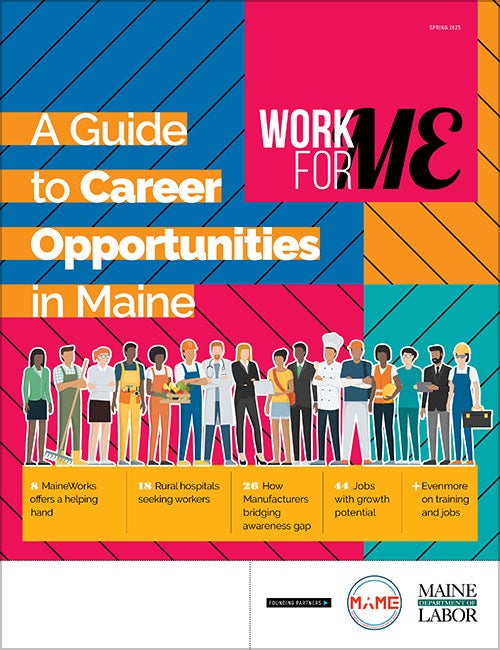Processing Your Payment
Please do not leave this page until complete. This can take a few moments.
- News
-
Editions
View Digital Editions
Biweekly Issues
- December 1, 2025
- Nov. 17, 2025
- November 03, 2025
- October 20, 2025
- October 6, 2025
- September 22, 2025
- + More
Special Editions
- Lists
- Viewpoints
-
Our Events
Event Info
Award Honorees
- Calendar
- Biz Marketplace
NEXT | Ten people shaping the future of Maine's economy
David Patch
President, Precision Light Systems, Brunswick
Strong bonds
David Patch has the kind of pragmatic approach to technology development you'd expect from a former Navy man and Pentagon project specialist. While he's as enamored of innovative products and new designs as anyone in the tech field, he's doesn't want researchers, academics and inventors to let their discoveries languish as mere science projects. Finding markets for those discoveries, he says, is the key.
For 10 years, Patch has been all over Maine's efforts to commercialize technology, first in the mid-90s as the director of industry development at the now-defunct Maine Science and Technology Foundation (its mission was superceded by the Maine Technology Institute), then as a private consultant and business manager. His latest effort, Brunswick-based Precision Light Systems, is developing a precision controlled laser welding technology that could help heavy industries like ship building and bridge construction create cheaper, lighter and stronger structural steel units.
Although the company is still working to land its first commercial sale, Patch's years in the technology development business taught him a key — and unorthodox — lesson about growing early-stage companies: Don't bother with the venture capital market. "VCs today are what the banks used to be 10 years ago," Patch says. "If you don't have sales of the product, they're not interested in you."
So how is Precision Light Systems making the transition from the R&D phase to becoming an operating company — a transition known as "The Valley of Death," to technologists? Patch says it's through collaboration, strategic partnerships and looking farther afield for funding sources, such as the federal government. And it's a technique he says more business in Maine could follow.
Precision Light Systems started with a welding technology first developed by the Navy, and has received $1.25 million in federal grants through Applied Thermal Sciences, a Sanford-based research and manufacturing firm, to find commercial applications for the technology. Patch partnered with Applied Thermal Sciences last year to create a fabrication facility in Sanford. Since then, the company has landed deals to test a steel T-beam design for Bath Iron Works, and has agreements to help commercialize the technology with two large industry players: the global welding and cutting firm ESAB and Comau-Pico, a manufacturer of assembly-line automation systems interested in Precision Light Systems' technology as part of its quest to expand beyond the automotive industry and into new, heavy manufacturing fields.
Patch knows striking such deals can be tricky for entrepreneurs, because most fear losing their autonomy to such bigger entities. But he says entrepreneurs need to keep in mind the bigger picture. "Part of the issue with entrepreneurs is that they don't want to give up control," he says. "By partnering you may end up losing control to some degree, but you don't give up your motivation for starting in the first place, which is to create something lasting, create jobs and create wealth."
His approach to partnerships and collaboration also applies to the state's efforts to commercialize its technology sectors as a whole. A firm believer in the need for Maine to focus on clusters to create strength and vibrant business activity, he points to the state's recent award of a $15 million federal grant to enhance the composites industry as a vital opportunity. That effort, though, requires Maine's sometimes fractured composites industry — which he says he knows well as a board member of the state's three Composite Technology Centers — to look beyond its individual needs and see, again, the bigger picture. "You've got to invest in areas where you're going to have a bigger payoff," he says.
More collaboration between Maine's state politicians, economic development agencies and its congressional delegation also is necessary, he says, to pursue more of those big funding opportunities. He's seen such single-minded focus bring Maine together to tackle the recent challenge of preserving military facilities during last year's Base Realignment and Closing process. Now, he says it's up to Maine's entrepreneurs to give public servants something similarly big to champion at the national level that will create new industries, not just preserve existing ones. "We've got to give them a project to support," Patch says. "It's not up to the state to do that, it's up to us."
Hannah Pingree and Josh Tardy
State representatives, North Haven and Newport
Across the aisle
A visit to the Maine Legislature in recent years would do little to dispel the notion that Maine has the nation's oldest population. Gray hair predominates. Some would say conventional wisdom does, too.
But there are fresh faces in the Legislature, members with bright political futures and clear ideas on what role policymakers should play in reviving the state's economy. The brightest of those rising stars are Reps. Josh Tardy and Hannah Pingree.
The two are far from alike. Tardy is a Republican. Pingree is a Democrat. And they have very different takes on which direction the state should take. Yet their commonalities are striking: Both joined the Legislature at an unusually young age. Both represent rural Maine. Both have a parent who served prominently in the Legislature. And both have shown willingness to compromise with opponents to get legislation passed.
Though they don't draw attention to it, Tardy, 38, and Pingree, 29, say their relative youth gives them a perspective on the Maine economy that older legislators might lack. For example, they know the Brain Drain well. "People from my high school and my college have gone away and stayed wherever they've gone, because the economy there is better," Tardy says.
Tardy, a graduate of the University of Maine and the University of Maine School of Law, lives in Newport. He was elected to the Legislature four years ago, when he was 34, and in the most recent session became the GOP's Assistant Floor Leader. Tardy's prescription for the Maine economy is typically conservative. Slashing both taxes and spending, he says, will help the economy flourish. "It starts with recognizing that the best thing government can do for business is stay out of the way of business," he says.
But Tardy's approach isn't purely laissez-faire. He believes government investment brings economic growth, and says the state needs to invest more in research and development to spur high-paying jobs. That's a strategy shared by Pingree, who has a more expansive view of the role of government in economic development. "Part of the reason that the U.S. is so economically successful is that we have the regulations and infrastructure in place that make a strong economy possible," says Pingree, who has pushed for spending to expand high-speed Internet access in rural areas, among other measures. "The government provides the infrastructure for our society."
Pingree, the daughter of former U.S. Senate candidate Chellie Pingree, lives and grew up on North Haven. She left Maine for Brown University in Rhode Island, then migrated to New York to work on an Internet-based nonprofit. She came home to aid her mom's 2002 Senate campaign, and soon after, at 26, was elected to the House. "I think young people bring a different brand of energy to the Legislature," Pingree says. "I don't think we have all the answers. But I think we have different answers, which is a good thing."
While she notes that rural and isolated areas of the state will likely remain difficult places to run a business, Pingree's prescription for the economy includes making the tax burden more fair for businesses and middle-income residents and increasing university funding. And, she says, a healthy dose of positive thinking wouldn't hurt. "To some degree, we've convinced ourselves that Maine is bad for business," Pingree says. "There need to be policy changes, but there also needs to be a sense of statewide optimism about the future."
Tardy and Pingree express frustration that lawmakers haven't been able to overcome partisan differences to address pressing problems — both cite the failure to achieve meaningful tax reform as an example. Still, each credits the other for being willing to reach across the aisle and consider opposing ideas.
Tardy and Pingree don't hide that they intend to someday run for higher office, though both say they lack a blueprint for their political futures. It's clear, though, that both are likely to be in the public eye for some time. "We came into the Legislature together, and she quickly established herself as a rising star of the Democratic Party," Tardy says. "She's certainly young, but I don't view her as a young leader of the party. I view her as a leader of the party."
Carol Noonan
Founder, Stone Mountain Arts Center, Brownfield
Sound and vision
Carol Noonan proved more than a few people wrong in August when she opened Stone Mountain Arts Center in Brownfield to a sold out crowd. It's no mystery rural Maine could use an economic boost, and the small town of Brownfield, with its 1,200 residents and small tourist trade, is no different. But not everybody has subscribed to the idea of economic development through the arts, and the concept of an arts center in western Maine produced its share of skeptics. "We had so many naysayers. Even our families were like, 'What are you doing? What makes you think people would come up here?'" Noonan says. "I just knew they would; I don't know why. Now, in hindsight, I think I was really lucky."
For the past few months the arts center, housed in a timber-frame barn behind Noonan's home, has drawn hundreds of people from as far south as Boston to listen to nationally known musical acts, pumping new life into the community. "Everything is selling out, it's the weirdest phenomenon I've ever seen," says Noonan, who is a nationally known folk musician herself.
In fact, Noonan, 47, found inspiration for her venture on the stage at grange halls and churches across New England. She always loved the crowds in the rural venues she played — an eccentric and diverse bunch that savored the few musical acts that came to town. But rural venues always left much to be desired in terms of comfort and sound quality. As she began tiring of touring — not to mention having to travel to Portland for cultural activities when she wasn't on the road — she began envisioning a new kind of rural arts venue.
Noonan and her husband, Jeff, who makes fishing nets for a living, decided last year to turn the barn on their property into a destination musical venue, complete with a state-of-the-art sound system, a bar and a commercial kitchen to serve dinner before the shows. "I'm at a point in my music career that I don't want to be on the road anymore, so we kind of needed to reinvent ourselves. And I think what's so cool about people in Maine is they're willing to do that and be independent," Noonan says. "But I think the real story is that you have to really go for it — you have to take a risk. I mean, nothing that's great is not a sacrifice and this certainly is."
Stone Mountain was in many respects a community project, with Noonan tapping the skills of many residents and relying on hundreds of volunteer hours to complete the project in a year's time. The result, she says, is a space that the community has embraced as its own.
As a case in point, she cites her opening this summer, which came amidst an acrimonious political dustup that resulted in a town selectmen getting ousted. Nevertheless, people on opposing sides of the issue were in the audience that night. "This was the one place that everybody could claim they were glad we had," she says.
The economic spin-off from the arts center also is clear. Every bed and breakfast has seen an increase in business on the nights there's a show, Noonan says. She's partnered with a few nearby inns to offer package deals, sometimes even running a shuttle between the arts center and an inn. "People love it," she says. "They come up and they stay at a nice inn and see a show — that's a perfect vacation."
But to keep the endeavor sustainable, Noonan knows she's going to have to bring variety to the center. Besides booking nationally known acts like bluegrass legend Ralph Stanley and folk singer Greg Brown — for which she charges $45 to $75, depending on how much it costs to book the musician — Noonan also puts on her own variety show, Stone Mountain LIVE, every month or so, bringing together anywhere from 10 to 20 musicians and other performers from all over New England. She also hopes to offer other affordable events for locals, such as lectures, wine tasting dinners or documentary movies.
But Noonan's business approach also needs to extend beyond hosting arts and cultural events. To supplement the small amount of money those events bring in, she says renting the space out for weddings will be her "bread and butter." In doing so, though, she could help nearby catering companies and other local businesses to grow as well.
She admits to being unsure of how that mix will fare, but says the only way to find out was to take a chance on Stone Mountain Arts Center. "So, if all this was a horrible idea — and we'll know in a couple of years — we lose a home that we love and a way of life we love," Noonan says.
So far, though, it seems to have been a good wager. And given its early success, Noonan believes the model could be replicated elsewhere in rural Maine, if communities were willing to take a similar chance. "I think these rural areas are totally ripe for it," Noonan says. "But nobody wants to take the risk and that's the problem in the arts. Everybody wants it to be given, wants it to be a grant or a donation."
Mitchell Rasor
Principal, MRLD, Yarmouth
Creating space
Mitchell Rasor admits he was brash when he moved to Maine in 1994. Fresh from Harvard with a masters degree in landscape architecture and a head full of ideas that hadn't seemed so fringe in Cambridge — ideas like designing physical spaces that foster community interaction and integrating art into design — Rasor soon discovered that working in Maine wouldn't be as easy as he had assumed. "The transition from academia to the market was more of a change here than in other places because the design climate is a bit more conservative and the development climate is a bit more conservative," Rasor says.
Regardless, Rasor decided to make his stand here, and has since challenged that conservative climate with several projects. In 2000, Rasor, now 38, founded MRLD, a firm that shirks easy definition. It began as a landscape architecture firm, but from one day to the next Rasor and his crew of five collaborators — they're not full-time employees, but are more than just independent contractors — work on everything from urban renewal projects and suburban residential communities to rewriting town ordinances. Rasor recently designed a first-of-its-kind shoreline stabilization project to prevent erosion in Freeport, and developed a master plan for Portland's eastern waterfront. He even dabbles in branding and website design for small businesses.
It might seem like a disparate collection of interests, but Rasor, who also is a record-producing musician and a sculptor, says every project his firm undertakes has a common theme. "To me it's all about some sense of place," Rasor says. "Ideally, for every [project] we do, my aspiration is that something about it brings a higher level of energy, a sense of 'ah-ha' to it — something unexpected, but something that still completely serves the purpose of the project."
Rasor's ideas for urban development, such as moving buildings closer to the streets and varying heights to create dynamic skylines, have received accolades from the design community, including a 2006 AIA Maine Design Excellence Award for the courtyard at the Preble Street Resource Center in Portland. Yet Rasor figures he avoids pursuing 70% of the available design work in Maine because he defines those projects as suburban sprawl. Most developers, Rasor says, take the path of least resistance and build on land away from a town center, which tends to be easier to develop and have fewer conflicts with neighbors and local officials.
By contrast, any project Rasor takes on must pass a simple test: It can't simply "consume" space, it must "make" space, such as his recent design for Portland bike shop Percy Cycles, which transformed a Congress Street storefront into a venue where bike enthusiasts can buy, build, fix or just talk about bikes. It also doubles as an art gallery. "The difference between making and consuming space is reflected in almost all of our projects," Rasor says.
In that effort, Rasor feels like a fish swimming upstream. By challenging conventions of standard design, however, Rasor's work demonstrates what is possible for Maine, if planners, developers and citizens take a broad view of how physical structures influence a community's social fabric. Integrating projects into the streetscape and creating spaces that encourage interaction can help revitalize Maine cities and towns, and show a compelling alternative to generic, strip-mall-style development taking place even in Maine's urban communities.
Not surprisingly, Rasor's projects sometimes ruffle a few feathers: Lupine Terrace, an award-winning affordable housing community he designed in Camden, currently is held up in Superior Court because of a classic case of NIMBYism. (A neighbor claims the local planning board was too capricious in its decision.) "We're opposing centrifugal forces, fighting that tide," Rasor says. "And in fighting that tideÂ… we're creating more friction, because we're trying to bring energy back into these communities."
That fight even includes offering unsolicited urban planning advice when Rasor sees the risks in the status quo. His current concern is that Portland will bungle the proposed Maine State Pier redevelopment and threaten existing public access. So he's working on what he calls a "guerilla plan" for the site that includes commercial space with rooftop parks, restaurants and an open-air theater at the end of the pier to show what could be done at the site if the city council resists approving a generic, mixed-use development. Though he admits the city is unlikely to accept his proposal, he hopes to inspire people to think more creatively about new uses for that space.
Rasor's commitment to showing Maine what's possible extends to one of his newest projects, a collaboration with the University of Southern Maine's resource computing group called Area Code. Area Code is a Web-based, interactive database of city and town ordinances that would allow anyone — from a commercial developer to a 10th grader working on a school report — to analyze a proposed development. By plugging in variables like the number of units or use of green technologies and materials, users could receive a host of scenarios gauging a project's chances for approval and potential rates of return for developers. "This doesn't exist anywhere in the world, and it would put Portland on the map in terms of innovative planning and innovative use of technology," Rasor says. "To me, it's a really important project because it bridges the worlds of paper-based planning and physical development, and is starting to bring those closer together in the dynamic, virtual world."
Wendy Porter
Director of environmental management, InterfaceFABRIC, Bangor
No compromise
A few years ago, Wendy Porter was asked by her company, Atlanta, Ga.-based Interface Inc., to check out a newly purchased textile factory in North Carolina. Part of the mill that housed the weaving operation was without air conditioning, subject to the oppressive summertime North Carolina heat. "Nobody wanted to work there because it was just miserable," Porter says.
Interface planned to solve the problem by installing an HVAC unit to cool the place down, but with a caveat: The company demanded that the unit be energy efficient.
It was a task right up Porter's alley. As director of environmental management for InterfaceFABRIC, the Guilford-based division of Interface that manufacturers fabrics for office furniture like chairs and drapes, Porter has been instrumental in helping the company meet a dual bottom line that melds environmental stewardship with fiscal responsibility — typically mutually exclusive pursuits on the corporate level.
Instead of simply finding and installing an efficient HVAC unit, Porter did much more: She transformed the manufacturing space — moving machinery, replacing windows and doors, repainting the interior — in a bid to make the entire factory more energy efficient. In the end, Interface spent 20% less than expected and installed a significantly smaller HVAC unit that will cost two-thirds less to run. And, employees no longer look down their noses at the space. "Now, it's the place to work," she says.
The secret? Systems thinking — a phrase that's not in the vocabulary of most U.S. companies, laments Porter. For example, most firms consider the problem — a lack of air conditioning, in this case — and solve it by tacking on an obvious solution like an HVAC unit. Instead, says Porter, companies can do better. In fact, they should do better by asking how else the problem could be solved, and what alternatives are available to get the job done in a way that's both environmentally and financially sound.
Whether finding eco-friendly ways to cool a hot factory or replacing toxic industrial solvents with safer alternatives, companies in Maine would do well to emulate Porter and her work at InterfaceFABRIC — and for more reasons than plain old environmentalist do-gooderism. Porter, 43, is among a small group in Maine's corporate world giving real-life examples of how companies can succeed financially without leaving a deep environmental footprint. Since 1994, when the company launched its current sustainability drive, Interface has reduced solid waste by 90%, a process that has helped save more than $300 million, according to Porter. "There's this mindset out there that being environmental means you have to compromise quality and increase costs, and that any alternative won't work as well and cost more," she says. "I've made my career out of disproving that."
In looking at Porter's success at InterfaceFABRIC, one can't discount the corporate culture of its parent company. Interface founder Ray Anderson has become a leading proponent of corporate sustainability, and a firm believer that a company's social and environmental goals can work in concert with its financial goals. It's Porter's role, however, to figure out how to put Anderson's visions and goals into practice.
At InterfaceFABRIC, Porter has helped further that sustainability mission by increasingly relying on recycled and other eco-friendly products for much of the company's manufacturing material. Chairs are upholstered in fabric made from old plastic soda bottles. At a conference table in the company's Bangor office, Porter holds a bag of plastic pellets made from cornstarch that will be turned into fabric for office drapes. (Her next goal is to use starch from the waste potatoes culled by Maine farmers to make fabric.)
At last year's NeoCon trade show, a gathering of national interiors manufacturers, Porter says the company won awards for both sustainability and design — with the same product. And while Porter was pleased by the win for sustainability, the design win was much sweeter. "It dispelled the notion that if it's environmental it also has to be ugly," she says.
D'arcy Main-Boyington and Tanya Pereira
Director of economic development and economic development specialist, city of Brewer
Beyond the quick fix
There's a toolbox that Maine's economic development officials all have. It's filled with state and federal programs designed to spur growth in a local economy. There are loans and tax incentives, training programs and economic subsidies.
But what if economic development officials confront a problem that no existing program, incentive package or other tool can fix? Some economic developers would throw in the towel, but for D'arcy Main-Boyington and Tanya Pereira, Brewer's economic development team, that's where their jobs start.
Main-Boyington, 38, a former employee of the Department of Economic and Community Development, formally took over as director of Brewer's economic development office in January. A few months later she lured Pereira, 30, to Brewer from Eastern Maine Development Corp. in Bangor. If they come up against a problem with no easy fix? "Me and Tanya will scratch our heads and say, 'Well, let's find out what we can make happen," says Main-Boyington. "We talk to the legislators and we talk to the Congress folks and we do whatever we have to do to come up with a creative solution."
That strategy has notched the pair some impressive wins. For example, Main-Boyington and Pereira helped attract Trillium Diagnostics, a biotech firm formerly based in Scarborough, to the Brewer Professional Center, the nascent business park near Interstate 395 that hosts the corporate offices of Eastern Maine Healthcare Systems and is slated to be the location of Eastern Maine Medical Center's new $41 million cancer care facility. Most notably, Main-Boyington and Pereira announced in September the city's selection of North Carolina-based Niemann Capital to redevelop the former Eastern Fine Paper Co. mill, a hulking brick structure on the city's waterfront that has remained vacant for more than two years.
What rarely gets reported, though, is the back story, in which Main-Boyington quietly pulled the plug on the city's 2005 plan to have Minneapolis-based developer Michael Stern transform the mill into housing, arts and retail space. Over time, as aspects of the development were scrapped to deal with ballooning costs, Main-Boyington figured the city would be better off starting anew. "The project became so different from when it started that I wasn't comfortable with it," she says. "It was a tough decision to make on my part, to remove the city from that, because it had been going for over a year and it had been highly public."
That focus on development that's the best fit for the city — and their belief that big, ambitious projects can happen in Brewer, despite the challenges — is critical to success, they say. So is a willingness to take risks. It's an approach that should be adopted by more of Maine's economic development officials, whose careful reliance on the well-known tools in their toolbox can result in missed opportunities.
Most recently, the pair has been tackling the problem of rising energy costs for the city's manufacturers. There's no easy answer. Instead, the duo is working on alternatives that Main-Boyington admits are risky.
The pair won't divulge any details of these daredevil strategies, but their willingness to broach even the most out-there idea helps broaden the notion of what municipal economic development can accomplish. "The businesses know that we're working on a solution [to the energy cost problem]," says Pereira. "I think they're very happy to see that we don't say, 'Well, that's really bigger than what a municipality can do.'"
And while Main-Boyington and Pereira have found success in a relatively short time, they're taking a longer view of what it means to create change in their community. "Economic development isn't a project-based process," says Pereira. "It's about building relationships with clients, with customers, with people in the region. Building relationships may not pay off in terms of tax dollars or jobs tomorrow, but it may pay off five or 10 years down the road."
Tim Spalding and Jeffrey Wood
Founder of LibraryThing, Portland, and president of eHope, Westbrook
Community connections
Technology is frequently fingered as an alienating force. Television, for example, has long been blamed for keeping Americans inside and isolated. In recent years, critics have cursed the Internet for the same reason. But two Mainers are proving the Internet can be a powerful tool for building connections — and organizations.
Jeffrey Wood, the founder of eHope in Westbrook, and Tim Spalding, founder of Portland-based LibraryThing, run social networking websites that use the Internet to create new and compelling communities. At first glance, perhaps, the pair have little in common. LibraryThing, which Spalding, 35, founded last year in his Munjoy Hill home, allows book lovers to catalogue online the books they own — and peek at the collections of others. LibraryThing has about 6.2 million catalogued books and 88,000 members, forming a devoted fan base that frequents the site and posts thoughts on a myriad of mostly bookish topics. It's an entertainment website, essentially, a community assembling to learn and enjoy.
Wood's mission is far different, and much more somber. eHope is a nonprofit devoted to helping people who are facing life-threatening illnesses, with a cadre of registered volunteers using websites to track how the ill person is faring and organize help he or she needs, such as delivering home-cooked meals or arranging transportation.
Wood, 48, founded eHope a couple of years back (the organization was certified as a nonprofit in August) and says the idea grew out of his experience helping a terminally ill neighbor. He says his site is about building community in what he sees as an age of increasing isolation, when many face terminal illness without a social safety net. "We know our neighbors through the blinds, and we make our assessments from afar," Wood says. "Then one day we look out the window and they're building a wheelchair ramp."
Though it has helped 25 terminally ill people at no charge, mostly in
southern Maine, eHope is very much a nascent organization of limited funding. In fact, Wood, by occupation a Web designer, estimates he has spent no more than $25,000 building his website and organization. "People look at our website and think we have a PR firm behind us," Wood says. "But that's just what I do.
LibraryThing is in a very different place. In May, Spalding sold a 40% stake in the business to online retailer AbeBooks.com, providing him with the funding (he declines to say how much) he needed to strengthen LibraryThing with a larger staff and technical upgrades. Spalding is now launching international versions of the site, and says about a million books are catalogued on the site every month. "LibraryThing is just so driven by the passion of its users," Spalding says. "We haven't paid for any PR. We haven't paid for any marketing."
The lesson? Web-based businesses can grow and prosper even in places, like Maine, that are away from the centers of high-technology. That's especially true, Spalding says, because the technological costs associated with launching a start-up have dramatically dropped. "A company like LibraryThing would have required millions of dollars in 1998, and I was able to fund this
myself," he says. "That's a powerful thing."
The communities built by social networking sites can be just as powerful for nonprofit entities, as eHope is showing. Like Spalding, Wood is ambitious, and he hopes to expand eHope beyond Maine's borders. "Our goal down the road is national," he says. But first things first: Wood would like to soon hire full-time staffers to help run the nonprofit. "It's very hard to run an organization with just volunteers," he says. "It's like herding cats."
Wood knows well the folly of many startups during the dot.com bubble of the late 1990s. He worked for an Old Port startup that tried to turn gardening into high-tech money. But it turns out, he says, that "people go to the garden to disconnect from technology, not to get connected to technology."
And he says he's wary of allowing eHope to grow too fast. It used to be (and for some startups, it's still the case) that the money
came before the results, before an Internet-based organization had an audience for its goods and services. But Spalding says low-cost technology has reversed that, allowing social networking sites to grow organically and ensure the idea is good before real financial investment occurs. And in Maine, where traditional financial investment has proved challenging for many startups, this new model looks a lot more feasible for local entrepreneurs -- and perhaps more sustainable. "Things are cheap enough now
that you can play with the idea before you need the money," Spalding says.
"Five years ago that wasn't true."
Chris Churchill
Mainebiz web partners

The Giving Guide
The Giving Guide helps nonprofits have the opportunity to showcase and differentiate their organizations so that businesses better understand how they can contribute to a nonprofit’s mission and work.
Learn More
Work for ME
Work for ME is a workforce development tool to help Maine’s employers target Maine’s emerging workforce. Work for ME highlights each industry, its impact on Maine’s economy, the jobs available to entry-level workers, the training and education needed to get a career started.
Learn More
Groundbreaking Maine
Whether you’re a developer, financer, architect, or industry enthusiast, Groundbreaking Maine is crafted to be your go-to source for valuable insights in Maine’s real estate and construction community.
Learn more-
The Giving Guide
The Giving Guide helps nonprofits have the opportunity to showcase and differentiate their organizations so that businesses better understand how they can contribute to a nonprofit’s mission and work.
-
Work for ME
Work for ME is a workforce development tool to help Maine’s employers target Maine’s emerging workforce. Work for ME highlights each industry, its impact on Maine’s economy, the jobs available to entry-level workers, the training and education needed to get a career started.
-
Groundbreaking Maine
Whether you’re a developer, financer, architect, or industry enthusiast, Groundbreaking Maine is crafted to be your go-to source for valuable insights in Maine’s real estate and construction community.
ABOUT
NEW ENGLAND BUSINESS MEDIA SITES
No articles left
Get access now
In order to use this feature, we need some information from you. You can also login or register for a free account.
By clicking submit you are agreeing to our cookie usage and Privacy Policy
Already have an account? Login
Already have an account? Login
Want to create an account? Register
Get access now
In order to use this feature, we need some information from you. You can also login or register for a free account.
By clicking submit you are agreeing to our cookie usage and Privacy Policy
Already have an account? Login
Already have an account? Login
Want to create an account? Register







Comments